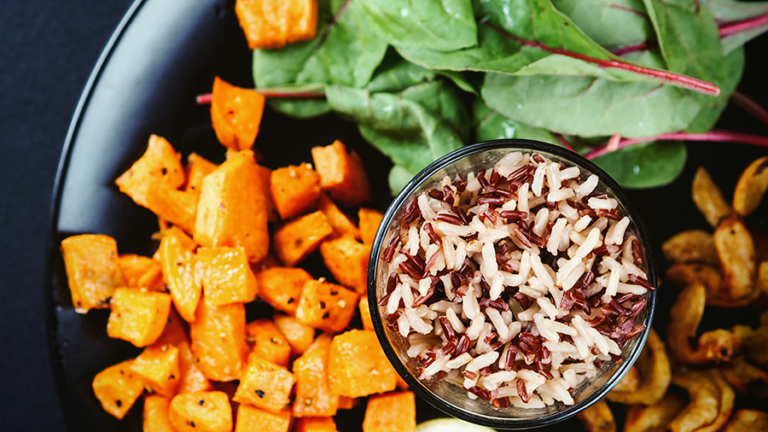My friend Laura, yes we are both called Laura, asked me if I had any more recipes to share. She’s been using my Banana Coconut Porridge recipe and was looking for dinner and lunch recipes that work for parents and babies.
I was kind of surprised when she asked me for more recipes, the internet is full of recipes, and I am hardly a food blogger. But then she followed it up with her fear that her 18-month-old still doesn’t have many teeth and it still makes her nervous for him to chew leafy greens and harder vegetables.
Vivienne recently coughed up a way-too-large chunk of apple that was supposed to be cooked, but didn’t cook all the way through—so I felt all of the other Laura’s feels.
One of the hardest things about the twins eating what we eat is that we’re not that into eating mushy food and they are. I’m not that into making two separate meals though, so we’re figuring it out.
There are a couple of tips I’ve picked up along the way that have made cooking for babies and their parents a lot easier.
(1) Cook for yourself first
I have started cooking what I want to eat first and then doctoring it to fit the babies’ needs. If I roast a bunch of cruciferous vegetables and find that they are still too crunchy for the girls, I just throw them in a pot to steam them until they are soft enough to not be a choking hazard.
(2) Follow the baby-led weaning approach to cutting and cooking your fruits veggies
After nearly choking my kids on multiple occasions, I finally got my act together and took the time to cook everything until it was soft and squish-able between my fingers.
We’re also trying to encourage the girls to feed themselves, so we cut vegetables that are roughly the size of a finger—a four-inch stick. (Once your baby has an established pincer grip, you can cut them smaller.)
(3) Don’t be afraid to puree
We used to puree everything, and once we got away from it, we got away from it. For a while, I was feeling guilty for even thinking about pureeing their food—like I was giving them baby food when they had already graduated to big kid food.
But pureed foods are easier to digest, it gives them experience with a different texture, and they can work on fine motor skills by feeding themselves. (I just ordered these toddler utensils that make it a little easier for them to feed themselves.
If I make a bean soup, I make it according to the recipe, and then I set some aside to puree for the girls because beans are still a little much for them to digest whole.
(4) Wait to add salt or any spicy condiments until after you’ve set aside the baby’s (or babies’) food.
Babies don’t need added salt and they don’t need their food loaded up with sriracha. Adding a tiny bit of salt to bring out flavors during cooking isn’t going to kill them, but go easy, sis.
Ok, now, it’s time to cook.
This is a very imprecise recipe because it’s one of those things you
This week I made a super quick veggie hash with all of the produce I needed to use up in my fridge. I used a lot of vegetables, but you could just as easily do this with two or three. To make it substantial, you do need at least one root vegetable and one cruciferous vegetable.
I served this over a bed of Fonio, which is a fluffy African super grain that cooks in 5 minutes, so we eat a lot of it.
Ingredients
Fingerling potatoes Parsnips Broccoli greens Kale Brussels sprouts As much olive oil as your heart desires (I like to cut my olive oil with grapeseed oil because grapeseed oil has a higher smoke point, and I like to get that oven hot!) 3 tablespoons Nutritional yeast 3 cloves of Garlic
Instructions:
Preheat the oven to 400 degrees
Roll your leafy greens up and slice them into strips and set them aside.
Peel and cut all vegetables to a baby-appropriate size.
Toss all the vegetables, except for the leafy greens, in a large bowl and toss with your oil mixture. Add your nutritional yeast and garlic, and stir until everything is coated.
Spread your veggies on a baking sheet. You can grease the sheet or use aluminum foil to line it—mama’s choice.
Bake for 30 minutes. (This would be a good time to make whatever grain you’re going to serve your veggies with.)
Pull your veggies out of the oven and toss your leafy greens in. If you need to add a little more oil to get the leafy greens coated, do not be afraid. (It’s not like it’s lard.) Put it back in the oven for 5 to 10 minutes, depending on how cooked you like your veggies. (I told you this recipe was imprecise from the start.)
Make it baby-friendly
If you remove your veggies from the oven when they are perfect for you, but you fear they are still too crunchy or dry for baby, put 4 tablespoons of water in a pan on the stove on medium heat, add baby’s veggies to the pan, and cover. Keep an eye on the pan, you may need to add more water to get to your desired softness—go easy though. The objective is to steam not boil.
Top it off
I like to top my veggies off with something sweet and spicy, like a little sriracha and a drizzle of honey, or something savory like a homemade nut cheese.

